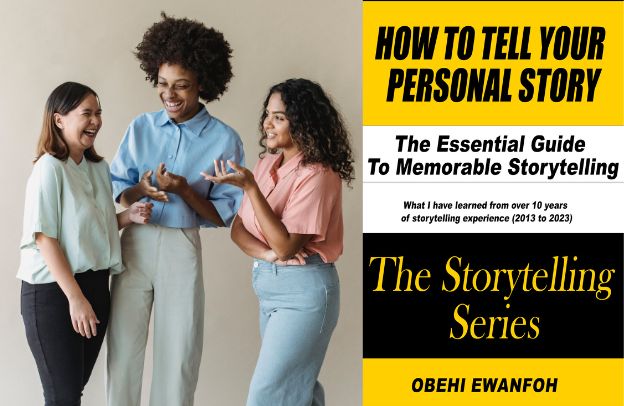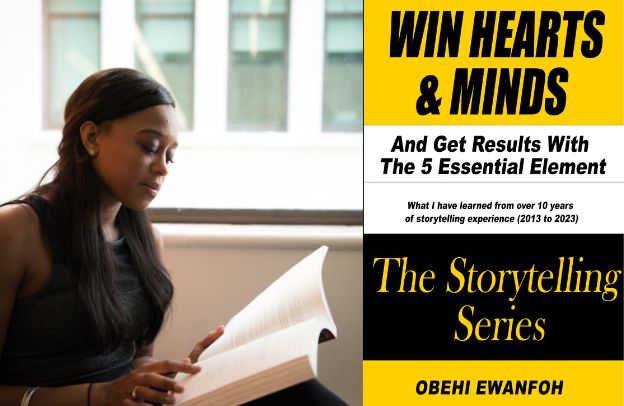Conflicts In Storytelling And How To Use It In Your Small Business
Are you struggling to overcome the challenges in your small business? Do you feel like your brand is not resonating with your target audience? Then sit back as we explore the importance of conflicts in storytelling and how you can leverage it for success in your small businesses.
Want to learn more about storytelling? Start by downloading the first chapter of The Storytelling Series for Small Businesses.
Today’s short read is from book two of The Storytelling Series for Small Businesses and Content Creators. The book is titled, WIN HEARTS & MINDS AND GET RESULTS With The 5 Essential Elements Of Storytelling and it’s available on Amazon if you want to get a copy for yourself and read along.
We are in chapter 4 of the book, and it’s created to help you understand all you need to know about conflict in storytelling from What is conflict in storytelling, types of conflicts, and how to create conflicts in your story. All these are essential to create a powerful story people can resonate with. Now the readying.
What is conflict in storytelling?
In storytelling, a conflict is when an external or internal struggle creates the starting point for a story. For example, in a superhero movie, the main character might have to battle an evil villain or stop the world from being taken over by aliens with powers.
In the words of Ronald Reagan, the 40th President of the United States, “Peace is not the absence of conflict, it is the ability to handle conflict by peaceful means.”
While that quote might be referring to a political situation, it works the same way in a literary work. A writer uses conflict as a way to tell their story and keep their audience engaged throughout the narration.
Five important conflicts in storytelling
Now, here are five important of conflicts in storytelling and I advise that you pay attention to every one of them:
- It drives the plot: Conflict is what drives the plot of a story, as it provides the problem or obstacle that the characters must overcome. Without conflict, there is no story.
- It creates tension and suspense: Using elements of conflict helps to create tension and suspense in a story, and this makes the reader wonder how the characters will overcome the problem or obstacle they are facing.
- It helps to develop the characters: Conflict helps to develop the characters in a story, as they must deal with and overcome challenges that test their abilities and their true natures.
- It adds depth and complexity to the story: The correct use of conflicts adds depth and complexity to a story, as it forces the characters to make difficult decisions and face tough consequences.
- It makes the story more relatable: Introducing confusion can turn an otherwise boring story into an interesting one. It can help make a story more relatable. It presents problems and challenges that are familiar to the reader in a way they can identify with.
Conflict is one of the most important elements in literature and film. It creates the narrative thread for a story, and that is what makes reading or watching a movie so interesting to the audience. When there is no conflict, there isn’t much of a story, which makes some stories boring to read.
There are three common types of conflict to choose from in your storytelling and they are person vs. person, person vs. nature, and person vs. self-conflict:
Person vs. person
There are many ways to create conflict within a story, but when one character’s goal is obstructed by another character, there are two different types of reactions that can arise: an argument or a physical confrontation.
Person vs. person is when another character or multiple characters obstruct the goal of the main character.
In a person vs. person conflict, one opponent will try to defeat the other by using words or brute force. TV series often depict protagonists and antagonists fighting with each other. Conflict may take many forms: it can be emotional or physical, such as when two people get into an argument.
Here are three examples of Person vs. Person conflict in popular movies:
- The Dark Knight (2008) – Batman (Christian Bale) vs. The Joker (Heath Ledger). This conflict is a battle of ideologies between Batman, who represents law and order, and The Joker, who represents chaos and anarchy.
- The Godfather (1972) – Michael Corleone (Al Pacino) vs. Sollozzo (Al Lettieri) and the other rival mafia families. This conflict is a struggle for power and control over the organized crime syndicate in New York City.
- Die Hard (1988) – John McClane (Bruce Willis) vs. Hans Gruber (Alan Rickman) and his gang of thieves. This conflict is a classic action thriller in which McClane, a police officer, must outsmart and defeat the terrorists who have taken over a Los Angeles skyscraper.
Try to rewatch each of these films for a better appreciation of what we are talking about here.
Person vs. nature
Person vs. Nature is a conflict between character and nature. Yes, this happens sometimes. Characters need to face challenges in the natural world, such as animals or diseases, which are beyond their control, and they need to face the opposing power of nature.
One of the most basic themes in literature is that of humans vs. nature as evident in such survival stories as Robinson Crusoe, The Jungle Book, and much more.
The story of Crusoe, for example, shows how a harmonious relationship with nature can develop under certain circumstances. Nature’s ever-changing appearance helps shape Robson’s psychology, and, in the end, he becomes more sensible and humbler than before.
Here are 5 effective ways to create Person vs. Nature conflicts in your storytelling:
- Natural disasters: Use natural disasters like hurricanes, earthquakes, wildfires, floods, or tornadoes to create conflict. The protagonist may be on the path of disaster and need to fight for survival.
- Wilderness survival: Place your protagonist in a wilderness setting where they must survive with limited resources. This could be a desert, jungle, or mountain range.
- Animal attacks: Use animal attacks like bears, wolves, or sharks to create a sense of danger and fear. Show the protagonists’ needs to defend themselves against the animal or find a way to escape.
- Environmental issues: Create conflict around environmental issues like pollution, global warming, or deforestation. The protagonist may be fighting to save a species or habitat.
- Man-made disasters: Use man-made disasters like oil spills, nuclear accidents, or chemical leaks to create conflict. Here, the protagonist may be trying to contain the damage or find a solution to the problem.
These are just a few examples of how you can create a Person vs. Nature conflict in your story. Remember to use vivid descriptions and sensory details to immerse your readers in the conflict and make it feel real.
As it often turns out, characters face challenges of nature that they cannot control, and they must either solve or overcome those obstacles to survive or restore order to their world.
In whichever way you choose to present this type of conflict, the audience needs to see your character facing resistance from the forces of nature. And whatever they do to the consequence is yours to explain as part of your storytelling.
Person vs. self
This type of conflict is also known as man vs. self-conflict and it’s a type of conflict that takes place in the mind of the character.
In a ‘person vs. self’ type of conflict, the character might be conflicted with their feelings and have opposing goals. An author can show this struggle between right and wrong choices, needs, or expectations.
Both in real life and in storytelling, there are situations when a character may be conflicted about their feelings or have two opposing goals.
This can be done by simultaneously putting two contradictory goals in the protagonist’s head, which forces him or her to choose between two choices, each with its pros and cons.
When a story is focused on the protagonist’s development in a person vs. type of conflict, they face an obstacle or problem that needs to be overcome. This problem might stem from the past and what they need is often explored throughout the narrative.
Whether in ‘person vs. self’ conflict, or any other type of conflict, you need to understand that conflict is an essential component of any story. It provides the tension that drives a narrative forward and brings about a deeper meaning in a story. It also reveals the characters’ motivations and values throughout the story.”
End of reading. Now, now how do you apply this knowledge to your business owner who wants to attract your audience or a leader of an organization who wants to build your influence? Let’s consider some recommendations.
How to leverage conflict as a small business owner or a leader of an organization
As a small business owner or a leader of an organization, it is important to correctly leverage conflicts to create opportunities for growth and success. Here are some tips on how to effectively do so:
- Embrace conflicts as a natural part of growth: Conflicts are a natural part of any business or organization, and they can be a positive force for growth and development. Recognize that conflicts can help your team identify areas for improvement and work together to find solutions.
- Encourage open communication: Create an environment where team members feel comfortable sharing their thoughts and opinions. Encourage open and honest communication to help prevent conflicts from escalating and allow for quick resolution when conflicts do arise.
- Use conflicts to identify areas for improvement: Conflicts can often highlight areas where your business or organization can improve. Use conflicts as an opportunity to identify these areas and work together to develop solutions.
- Foster a culture of collaboration: Encourage your team members to work together to find solutions to conflicts. Foster a culture of collaboration and encourage team members to brainstorm ideas and work together to find creative solutions.
- Learn from conflicts: Use conflicts as an opportunity to learn and grow. After a conflict has been resolved, take the time to reflect on what you have learned and how you can apply these lessons to future situations.
Your Takeaway
Conflict is a fundamental element in all successful stories, and they are what help the professional to stand out in their small business ecosystem. By leveraging conflicts as a small business owner or a leader of an organization, you can create a more collaborative and productive environment.
The five-part book series is also available on Amazon so you can order your copies from there. Have a good reading and remember to share your thoughts and inspirations about the series.
Want to learn more about storytelling? Start by downloading the first chapter of The Storytelling Series for Small Businesses.







